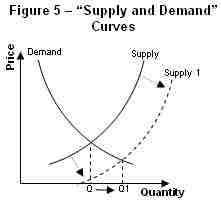The price elasticity of supply (PES) is the measure of the responsiveness of the quantity supplied of a particular good to a change in price (PES = % Change in QS / % Change in Price). The intent of determining the price elasticity of supply is to show how a change in price impacts the amount of a good that is supplied to consumers. The price elasticity of supply is directly related to consumer demand.
Elasticity
The elasticity of a good provides a measure of how sensitive one variable is to changes in another variable. In this case, the price elasticity of supply determines how sensitive the quantity supplied is to the price of the good.
Calculating the PES
When calculating the price elasticity of supply, economists determine whether the quantity supplied of a good is elastic or inelastic. The percentage of change in supply is divided by the percentage of change in price. The results are analyzed using the following range of values:
- PES > 1: Supply is elastic.
- PES < 1: Supply is inelastic.
- PES = 0: Supply is perfectly inelastic. There is no change in quantity if prices change.
- PES = infinity: Supply is perfectly elastic. An decrease in prices will lead to zero units produced.
Factors that Influence the PES
There are numerous factors that impact the price elasticity of supply including the number of producers, spare capacity, ease of switching, ease of storage, length of production period, time period of training, factor mobility, and how costs react.
The price elasticity of supply is calculated and can be graphed on a demand curve to illustrate the relationship between the supply and price of the good .

Supply and Demand Curves
A demand curve is used to graph the impact that a change in price has on the supply and demand of a good.